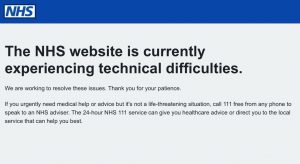24 hours in from 1st AZ Covid jab. Right as rain until about 2 hours ago when arm ache kicked in, also feeling pretty sluggish now but that’s fairly normal after a day of brain numbing graft – seeing side effects everywhere kind!
24 hours in from 1st AZ Covid jab. Right as rain until about 2 hours ago when arm ache kicked in, also feeling pretty sluggish now but that’s fairly normal after a day of brain numbing graft – seeing side effects everywhere kind!
From Twitter: https://twitter.com/andyf…
North East Rugby folks – anyone know who looks after the forum hosting at https://t.co/M9KQviviM9 as it’s been broken for a good while now – does it need a kick, does it need techy input (half volunteering?) 🤔
North East Rugby folks – anyone know who looks after the forum hosting at https://t.co/M9KQviviM9 as it’s been broken for a good while now – does it need a kick, does it need techy input (half volunteering?) 🤔
From Twitter: https://twitter.com/andyf…
Joined the jab club, and a sticker for being brave 💪💉
Joined the jab club, and a sticker for being brave 💪💉
Joined the jab club, and a sticker for being brave 💪💉
From Instagram: https://www.instagram.com…
Negatives: Kettle blew up Positives: Covid jab booked 💉
Negatives: Kettle blew up
Positives: Covid jab booked 💉
From Twitter: https://twitter.com/andyf…
A lot of over 45’s out there I guess!
A lot of over 45’s out there I guess!
A lot of over 45’s out there I guess!
From Instagram: https://www.instagram.com…
Yesterday I was mocking everyone who planned to sit outside a pub daytime drinking in the snow – today I’m jealous!
Yesterday I was mocking everyone who planned to sit outside a pub daytime drinking in the snow – today I’m jealous!
From Twitter: https://twitter.com/andyf…
Achmed The Dead Terrorist: Jingle Bombs”
Achmed The Dead Terrorist: Jingle Bombs
And people say I don’t get in the Xmas spirit, been having a shing shong today 🙂
WTF? >> Hundreds of fake McDonald’s coffee stickers found in man’s car
Hundreds of fake McDonald’s coffee stickers found in man’s car – BBC News:
The driver in Bradford was found with multiple sheets of stickers, similar to ones McDonald’s customers are given when they buy hot drinks.
Police said he was trying to defraud the loyalty scheme, in which six stickers can be exchanged for a free coffee.
Of all the things in the world to counterfeit, free coffee vouchers!
Saracens statement regards the salary cap appeal
Club Statement on behalf of Nigel Wray – Saracens:
Saracens today confirms that it is not going to appeal the recent ruling of the independent panel in relation to salary cap breaches.
Pretty much as expected, B-Team out in European fixtures and hoping for the best, A-Team all out for Bonus points in the Prem
#Saracens docked 35 points and fined £5.3m for breaching salary cap rules
Wowsers, always knew they supported their players more than other clubs, because, well, £££, but never thought they’d ever get punished
Saracens docked 35 points and fined £5.3m for breaching salary cap rules – BBC Sport:
Saracens docked 35 points and fined £5.3m for breaching salary cap rules






